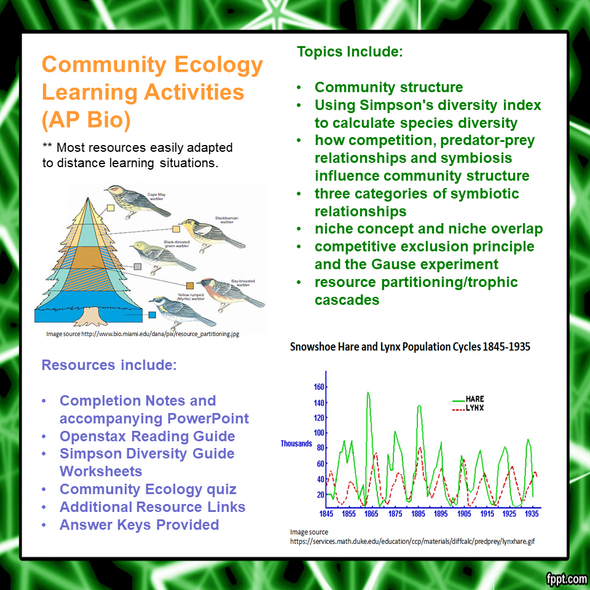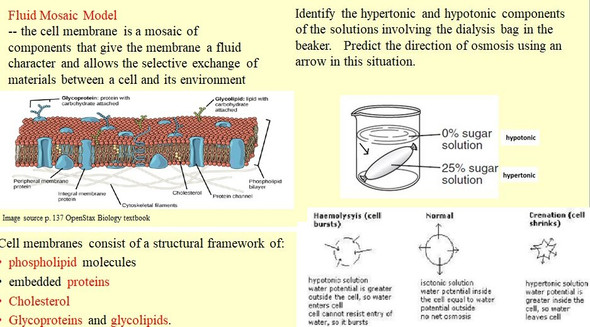Population Ecology Learning Activities for AP Biology (Distance Learning)
- Bulk Pricing:
- Buy in bulk and save
- Contributor:
- Monday's Rescue
- Grade Level:
- 9-12
- Product Type:
- Learning Package (Notes, PowerPoint, Homework)
- File Type:
- doc, pdf, ppt
- Pages:
- 25
- Answer Key:
- Yes
Description
This zip file contains many different activities (55 pages of student handouts and 1 PowerPoint with a total of 42 slides) which can be used to compose a unit for AP Biology or advanced Biology students involving aspects of population ecology. Topics in this unit include population density, patterns of dispersion, r V k-selection, factors influencing population growth, age structure, survivorship curves, carrying capacity, limiting factors, density dependent and density independent factors, exponential and logistic growth models and human population growth, Simpson's diversity index and other topics. Population ecology computations such as rate, population growth, exponential growth and logistic growth are addressed through the population density practice problems worksheet. The learning guides/assignments contain links to online resources to support student learning. This package of learning activities has been updated to reflect the changes in the 2019-2020 AP curriculum.
This lesson packet contains a listing of the learning goals, common core learning standards, NGSS learning standards and the AP Biology performance indicators addressed in these materials. These are included in the packet and at the end of the description of this lesson.
Most documents are included in both word and pdf format to allow editing for specific teacher needs. These learning materials are well suited for a distance learning situation.
Answer keys are included for all student work items with the exception of data for the lab activities (as the answers and data obtained by students can exhibit a good deal of variation).
The specific contents of the learning package includes the following items (the page count for these items are actual student handouts as answer key page counts are not included):
-- Population Ecology Completion Notes (16 pp)
-- Population Ecology PowerPoint to accompany the completion notes (42 slides)
-- Population Ecology Practice Problems Worksheet (20 problems) (8 pp)
-- Simpson's Diversity Index Calculations Worksheet (3 pp)
-- Introduction to Population Ecology Activity (involves reading, writing, data graphing and data interpretation of population scenarios involving the Kaibab deer and the moose-wolf interactions on Isle Royale) (12 pp)
-- Population Ecology Reading Homework (uses free open stax reading or own textbook reading information to answer questions) (34 questions) (6 pp)
-- Population Ecology Exam (contains 37 multiple choice questions and 4 short answer questions or problems) (8 pp)
-- Population Ecology Objectives and Learning Goals (correlated to AP Biology ETS LOs as well as the NGSS and Common Core Learning Standards) (3 pp)
Population Ecology Objectives and Learning Goals
ETS Learning Objectives:
Enduring Understanding
Living systems are organized in a hierarchy of structural levels that interact.
Learning Objectives
SYI 1.G Describe factors that influence growth dynamics of populations.
SYI 1.H Explain how the density of a population affects and is determined by resource availability in the environment.
NGSS Learning Standards Addressed
Students who demonstrate understanding can:
HS-LS2-1. Use mathematical and/or computational representations to support explanations of factors that affect carrying capacity of ecosystems at different scales.
HS-LS2-2. Use mathematical representations to support and revise explanations based on evidence about factors affecting biodiversity and populations in ecosystems of different scales.
HS-LS2-6. Evaluate the claims, evidence, and reasoning that the complex interactions in ecosystems maintain relatively consistent numbers and types of organisms in stable conditions, but changing conditions may result in a new ecosystem
Common Core State Standards Connections:
ELA/Literacy
RST.9-10.8 Assess the extent to which the reasoning and evidence in a text support the author’s claim or a recommendation for solving a scientific or technical problem.
RST.11-12.1 Cite specific textual evidence to support analysis of science and technical texts, attending to important distinctions the author makes and to any gaps or inconsistencies in the account.
RST.11-12.7 Integrate and evaluate multiple sources of information presented in diverse formats and media (e.g., quantitative data, video, multimedia) in order to address a question or solve a problem.
RST.11-12.8 Evaluate the hypotheses, data, analysis, and conclusions in a science or technical text, verifying the data when possible and corroborating or challenging conclusions with other sources of information.
WHST.9-12.2 Write informative/explanatory texts, including the narration of historical events, scientific procedures/ experiments, or technical processes.
Mathematics
MP.2 Reason abstractly and quantitatively.
MP.4 Model with mathematics.
HSN-Q.A.1 Use units as a way to understand problems and to guide the solution of multi-step problems; choose and interpret units consistently in formulas; choose and interpret the scale and the origin in graphs and data displays.
HSN-Q.A.2 Define appropriate quantities for the purpose of descriptive modeling.
HSN-Q.A.3 Choose a level of accuracy appropriate to limitations on measurement when reporting quantities.
HSS-ID.A.1 Represent data with plots on the real number line.
Student Learning Objectives (local)
Upon the completion of this unit the student will be able to:
1. briefly explain several aspects of population ecology.
2. distinguish between density and dispersion.
3. explain how ecologists measure density of a species.
4. describe conditions which may result in clumped dispersion, random dispersion, and uniform dispersion of populations.
5. explain how age structure and generation time can affect population growth.
6. describe the characteristics of populations which exhibit Type I, Type II, and Type III survivorship curves.
7. explain how carrying capacity of the environment affects the intrinsic rate of increase of a population.
8. explain how density-dependent factors affect population growth.
9. describe how weather and climate can function as density-independent factors in controlling population growth.
10. explain how density-dependent and density-independent factors may work together to control a population's growth.
11. explain how predation can affect life history through natural selection.
12. distinguish between r-selected populations and K-selected populations.
13. explain how interspecific competition may affect community structure.
14. calculate the growth rate of a population.
15. distinguish between logistic and exponential growth and calculate the rate of either type of population growth.
16. explain what is meant by biodiversity.
17. be able to calculate Simpson's diversity index to describe biodiversity mathematically given a sample of a populations of organisms in a sample.
Terms of Use
Purchase of the product is for classroom use by the purchaser only. It is a violation for individuals, schools, and districts to redistribute, sell, or post this item on the Internet or to other individuals.
This work is licensed under a Creative Commons Attribution-NonCommercial-ShareAlike 4.0 International License.
This learning package bundle is part of the AP Biology Complete Course. The complete course contains 22 learning package bundles in addition to this one. Save nearly 60% over the cost of buying 23 individual unit learning bundles with your purchase of the complete course.
Check out Monday's Rescue for more great resources!














